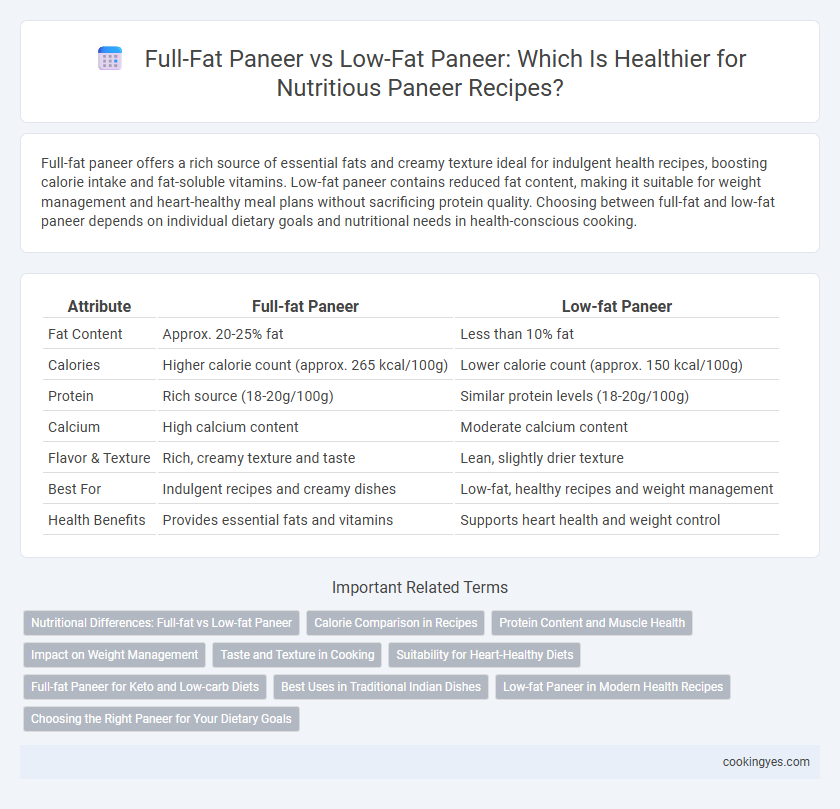Full-fat paneer offers a rich source of essential fats and creamy texture ideal for indulgent health recipes, boosting calorie intake and fat-soluble vitamins. Low-fat paneer contains reduced fat content, making it suitable for weight management and heart-healthy meal plans without sacrificing protein quality. Choosing between full-fat and low-fat paneer depends on individual dietary goals and nutritional needs in health-conscious cooking.
Table of Comparison
| Attribute | Full-fat Paneer | Low-fat Paneer |
|---|---|---|
| Fat Content | Approx. 20-25% fat | Less than 10% fat |
| Calories | Higher calorie count (approx. 265 kcal/100g) | Lower calorie count (approx. 150 kcal/100g) |
| Protein | Rich source (18-20g/100g) | Similar protein levels (18-20g/100g) |
| Calcium | High calcium content | Moderate calcium content |
| Flavor & Texture | Rich, creamy texture and taste | Lean, slightly drier texture |
| Best For | Indulgent recipes and creamy dishes | Low-fat, healthy recipes and weight management |
| Health Benefits | Provides essential fats and vitamins | Supports heart health and weight control |
Nutritional Differences: Full-fat vs Low-fat Paneer
Full-fat paneer contains higher amounts of saturated fats and calories, making it richer and creamier, while low-fat paneer offers reduced fat content with a leaner profile suitable for calorie-conscious diets. Both types provide significant protein and calcium, but low-fat paneer minimizes fat intake without compromising essential nutrients. Choosing between full-fat and low-fat paneer depends on dietary goals, balancing taste with nutritional needs in health-focused recipes.
Calorie Comparison in Recipes
Full-fat paneer contains approximately 265 calories per 100 grams, making it richer and more suitable for recipes requiring creaminess and satiety. Low-fat paneer, with around 150 calories per 100 grams, supports calorie-controlled diets while still providing essential protein and calcium. Choosing between the two depends on the desired calorie content in health recipes, balancing taste and nutritional goals.
Protein Content and Muscle Health
Full-fat paneer contains approximately 18 grams of protein per 100 grams, supporting muscle repair and growth with its rich amino acid profile. Low-fat paneer offers a reduced calorie option while still providing around 16 grams of protein per 100 grams, making it suitable for lean muscle maintenance and weight-conscious diets. Both varieties deliver essential nutrients, but full-fat paneer may enhance satiety and energy levels during muscle-building phases.
Impact on Weight Management
Full-fat paneer contains higher saturated fat and calorie content, which can contribute to increased energy intake and potential weight gain if consumed excessively. Low-fat paneer offers reduced calorie density while maintaining protein content, making it a preferable choice for weight management and calorie-controlled diets. Incorporating low-fat paneer into health recipes supports lean muscle maintenance and satiety without significantly impacting overall fat intake.
Taste and Texture in Cooking
Full-fat paneer offers a richer, creamier texture and more pronounced flavor, enhancing dishes like curries and snacks where indulgence is key. Low-fat paneer provides a firmer, drier texture with a milder taste, suitable for health-conscious recipes that require less oil or fat. Choosing between full-fat and low-fat paneer depends on balancing caloric intake with desired mouthfeel and taste complexity in meals.
Suitability for Heart-Healthy Diets
Full-fat paneer contains higher levels of saturated fats, which may increase LDL cholesterol and impact heart health negatively when consumed in excess. Low-fat paneer offers a reduced fat profile while maintaining essential proteins and calcium, making it more suitable for heart-healthy diets focused on lowering saturated fat intake. Choosing low-fat paneer supports cardiovascular wellness by reducing the risk factors associated with heart disease without sacrificing nutrient density in health-conscious recipes.
Full-fat Paneer for Keto and Low-carb Diets
Full-fat paneer is rich in healthy fats and protein, making it an ideal ingredient for keto and low-carb diets that emphasize fat intake for sustained energy. Low-fat paneer contains fewer calories and less fat but may lack the satiety benefits essential for ketosis and weight management. Incorporating full-fat paneer into health recipes supports optimal fat consumption while maintaining low carbohydrate levels crucial for ketogenic lifestyle success.
Best Uses in Traditional Indian Dishes
Full-fat paneer offers a rich, creamy texture ideal for indulgent traditional Indian dishes like Paneer Butter Masala and Shahi Paneer, enhancing flavor and mouthfeel. Low-fat paneer suits lighter recipes such as Palak Paneer or Paneer Tikka, providing protein with reduced calories and fat content for health-conscious diets. Choosing between full-fat and low-fat paneer depends on the dish's richness and nutritional goals, balancing taste with health benefits in Indian cuisine.
Low-fat Paneer in Modern Health Recipes
Low-fat paneer contains reduced saturated fat and calories, making it ideal for health-conscious recipes focused on weight management and heart health. It provides high-quality protein and essential calcium without compromising taste or texture in modern dishes. Incorporating low-fat paneer supports balanced nutrition while complementing salads, stir-fries, and smoothies in contemporary health-focused meal plans.
Choosing the Right Paneer for Your Dietary Goals
Full-fat paneer contains higher levels of fat and calories, making it ideal for recipes that require a rich texture and flavor, especially in weight maintenance or muscle-building diets. Low-fat paneer offers reduced fat content and fewer calories, suitable for weight loss or heart-healthy meal plans, while still providing a good source of protein and calcium. Selecting the right paneer depends on balancing dietary goals with recipe requirements, ensuring optimal nutrition and taste.
Full-fat Paneer vs Low-fat Paneer for health recipes Infographic

 cookingyes.com
cookingyes.com